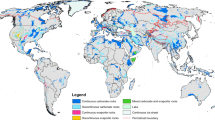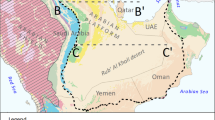Abstract
The results of the study of cryogenic landforms (heave mounds and thermokarst depressions) and soils developed on them under conditions of the ultracontinental climate of Buryatia and relatively shallow permafrost are discussed. According to the analysis of data of a Tandem X radar and terrain geomorphic surveys, the spatial distribution of local heave mounds and depressions in the Eravna Basin in the south of the Vitim Plateau has been mapped. Heave mounds are mainly allocated to watersheds and foothill fans; soils formed on them are represented by gleyic cryoturbated chernozems (Haplic Chernozems (Stagnic, Turbic) and gleyic dark-humus soils (Stagnic Phaeozems). Thermokarst depressions are allocated to the bottom of the basin and to the wide leveled loamy watersheds. The soil cover here is formed by quasigley chernozems (Gleyic Chernozems) and calcareous quasigley humus soils on stratified lacustrine sediments (Calcaric Gleyic Phaeozems). The soils of heave mounds and thermokarst depressions are characterized by considerable variation in the thickness of horizons and their inversion because of frost heave and cryoturbation processes. They pronouncedly differ in morphology and physical and chemical properties. The distribution of carbon pools in the profiles of these soils differs considerably from that in the background quasi-gley chernozems (Gleyic Chernozems).





Similar content being viewed by others
REFERENCES
Agrochemical Methods of Soil Study (Nauka, Moscow, 1975) [in Russian].
S. A. Blagodatskii, E. V. Blagodatskii, A. Yu. Gorbenko, and N. S. Panikov, “Determination of microbial biomass in soil by rehydratation method,” Pochvovedenie, No. 4, 64–71 (1987).
Yu. K. Vasil’chuk, N. A. Budantseva, A. K. Vasil’chuk, Yu. N. Chizhova, and Yu. V. Stanilovskaya, “Migrational heave mounds in the permafrost zone of Eastern Siberia and the Far East,” Inzh. Geol., No. 1, 40–46 (2014). https://doi.org/10.25296/1993-5056-2014-1-40-64
R. V. Desyatkin, Pedogenesis in Thermokarst Depressions-Alases of the Permafrost Zone (Nauka, Novosibirsk, 2008) [in Russian].
D. V. Karelin and D. G. Zamolodchikov, Carbon Exchange in Cryogenic Ecosystems (Nauka, Moscow, 2008) [in Russian].
A. A. Kozlova, V. A. Kuz’min, and E. V. Naprasnikova, “Functioning of soils in the hummocky–hollow ecosystems of the upper Angara region,” Contemp. Probl. Ecol. 3, 284–291 (2010).
A. A. Kozlova, V. A. Kuz’min, and E. P. Zazovskaya, “Soils of paleocryogenic hummocky–hollow landscapes in the southern Baikal region,” Eurasian Soil Sci. 47, 360–370 (2014).
A. I. Kulikov, L. L. Ubugunov, and A. Ts. Mangataev, “Global climate change and its impact on ecosystems,” Arid Ecosyst. 4, 135–141 (2014).
N. L. Mel’nichuk, “Geocryological conditions of the southern part of the Vitim plateau,” in Geocryological Conditions of Transbaikalia and Cis-Baikal Region (Nauka, Moscow, 1967), pp. 71–79.
V. V. Paromov, V. A. Zemtsov, and S. G. Kopysov, “Climate of Western Siberia during slow warming (1986–2015) and forecasting of hydroclimatic resources for 2021–2030,” Izv. Tomsk. Politekh. Univ., Inzh. Georesur. 328 (1), 62–74 (2017).
Field Guide for Identification of Russian Soils (Dokuchaev Soil Science Inst., Moscow, 2008) [in Russian].
Ya. G. Ryskov, S. V. Mergel’, E. A. Arlashina, O. S. Khokhlova, and E. G. Morgun, “Emission and flux of CO2 in soils containing carbonates,” in Soil Respiration (Scientific Center of Biological Research, Russian Academy of Sciences, Pushchino, 1993), pp. 107–124.
Yu. B. Tsybenov, G. D. Chimitdorzhieva, E. O. Chimitdorzhieva, R. A. Egorova, E. Yu. Mil’kheev, T. V. Davydova, and Ts.D.-Ts. Korsunova, “Morphology and physical properties of soil material in cryogenic cracks of permafrost-affected meadow-chernozemic soils of the Trans-Baikal region,” Eurasian Soil Sci. 49, 908–914 (2016). https://doi.org/10.1134/S1064229316080159
G. D. Chimitdorzhieva, Organic Matter of Cold Soils (Ulan-Ude, 2016) [in Russian].
E. O. Chimitdorzhieva, Yu. B. Tsybenov, and G. D. Chimitdorzhieva, “Carbon of humus-containing cryogenic pedofeatures in hydrometamorphized chernozems of Transbaikalia,” Agrokhimiya, No. 9, 14–19 (2015).
G. D. Chimitdorzhieva, E. O. Chimitdorzhieva, Yu. B. Tsybenov, R. A. Egorova, E. Yu. Mil’kheev, A. N. Mukhacheva, and I. A. Yablokova, “Characteristic of soils of thermokarst depressions and heave mounds in the south of the Vitim Plateau,” Agrokhimiya, No. 11, 52–57 (2017). https://doi.org/10.7868/S0002188117110060
D. B. Andreeva, K. Leiber, B. Glaser, U. Hambach, M. Erbajeva, G. D. Chimitdorgieva, V. Tashak, and W. Zech, “Genesis and properties of black soils in Buryatia, southeastern Siberia, Russia,” Quart. Int. 243, 313–326 (2011). https://doi.org/10.1016/j.quaint.2010.12.017
T. N. Chimitdorzhiev, P. N. Dagurov, M. E. Bykov, A. V. Dmitriev, and I. I. Kirbizhekova, “Comparison of Alos Palsar interferometry and field geodetic leveling for marshy soil thaw/freeze monitoring, case study from the Baikal lake region, Russia,” J. Appl. Remote Sens. 10 (1), 016006 (2016).
A. I. Zakharov, M. I. Epov, V. L. Mironov, T. N. Chymitdorzhiev, M. E. Bykov, V. S. Seleznev, A. F. Emanov, and V. A. Cherepenin, “Earth surface subsidence in the Kuznetsk coal basin caused by manmade and natural seismic activity according to Alos Palsar interferometry,” IEEE J. Sel. Top. Appl. Earth Obs. Remote Sens. 6 (3), 1578–1583 (2013).
E. A. G. Schuur, J. Bockheim, J. G. Canadell, E. Euskirchen, C. B. Field, S. V. Goryachkin, S. Hagemann, P. Kuhry, P. M. Lafleur, H. Lee, G. Mazhitova, F. E. Nelson, A. Rince, V. E. Romanovsky, et al., “Vulnerability of permafrost carbon to climate change: implications for the global carbon cycle,” BioScience 58, 701–714 (2008). https://doi.org/10.1641/B580807
C. Tarnocai, J. G. Canadell, E. A. G. Schuur, P. Kuhry, G. Mazhitova, and S. Zimov, “Soil organic carbon pools in the northern circumpolar permafrost region,” Global Biogeochem. Cycles 23 (2), GB2023 (2009). https://doi.org/10.1029/2008GB00332722
K. Schaefer, H. Lantuit, V. E. Romanovsky, E. A. G. Schuur, and R. Witt, “The impact of the permafrost carbon feedback on global climate,” Environ. Res. Lett. 9 (085003), 9 (2014). https://doi.org/10.1088/1748-9326/9/8/085003
ACKNOWLEDGMENTS
The authors are grateful to the Japan Aerospace Exploration Agency for ALOS PALSAR and ALOS-2 PALSAR-2 data provided within the framework of project RA6 (PI 3402) and to the German Aerospace Center for TanDEM-X data provide within the framework of project XTI_HYDR0485.
Funding
Field studies were supported by the state budget research program no. АААА-А 17-117011810038-7. Analytical works were supported by the Russian Foundation for Basic Research, project no. 16-04-01297. Interferometry studies by A.V. Dmitriev and T.N. Chimitdorzhiev were performed within the framework of state contract no. 0336-2019-0005 “Microwave Interferometry and Polarimetry in Remote Sensing of the Earth Surface.”
Author information
Authors and Affiliations
Corresponding author
Additional information
Translated by I. Bel’chenko
Rights and permissions
About this article
Cite this article
Chimitdorzhieva, G.D., Chimitdorzhieva, E.O., Milkheev, E.Y. et al. Soils of Cryogenic Landforms in the South of the Vitim Plateau: Distribution and Role in the Allocation of Soil Carbon Pools. Eurasian Soil Sc. 52, 1019–1027 (2019). https://doi.org/10.1134/S1064229319090023
Received:
Revised:
Accepted:
Published:
Issue Date:
DOI: https://doi.org/10.1134/S1064229319090023




